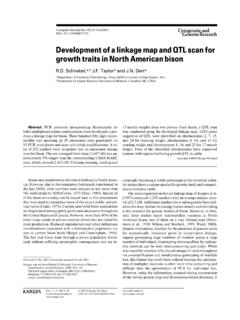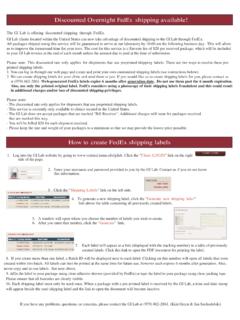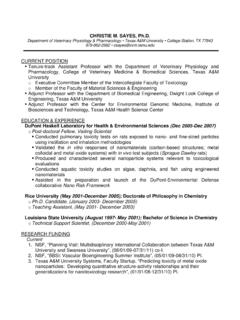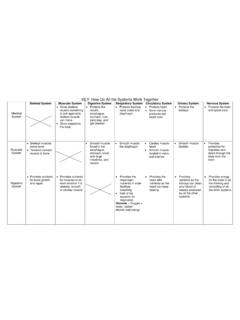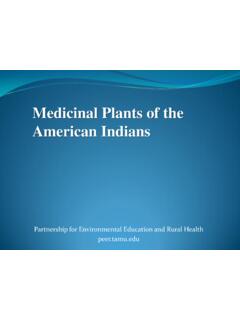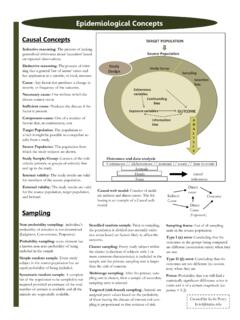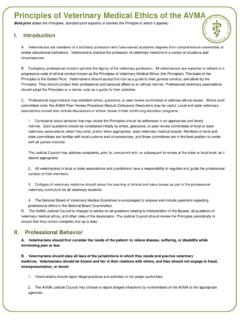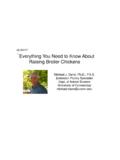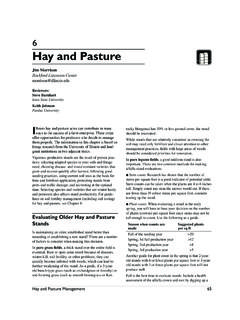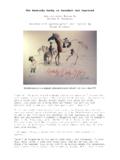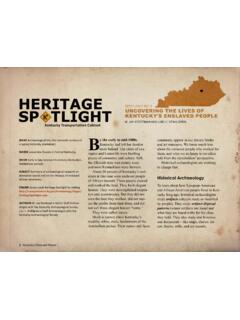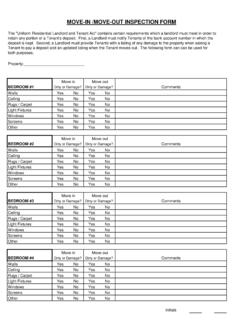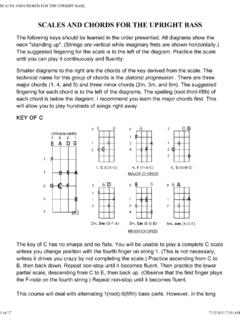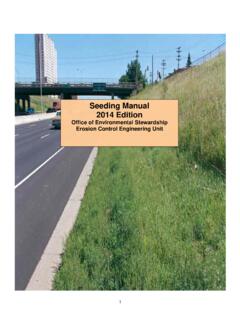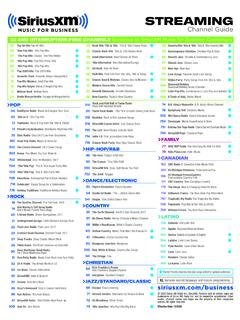Transcription of Fetal Pig Dissection - Texas A&M College of Veterinary ...
1 Fetal Pig Dissection What do you think humans have in common with the pig? Humans and Pigs may be closer than you think! Both are mammals We share common body systems The anatomy of the pig is close to that of humans The Fetal pigs will tell us more about our own bodies and give us a way to explore! SAFETY FIRST! NEVER point sharp Wash hand at the objects at yourself or end of each class others period Always cut/make Don't remove any incisions away form specimens from the yourself and others classroom No horseplay in the Properly dispose of lab any materials Properly mount Clean up area specimens to the Dissection pan Descriptive words are used to describe where on an animal. Like using North, South, East, or West for locations on a map. Dorsal -- toward the back Ventral -- toward the front/belly Separated by the frontal plane V. Cranial -- toward the head Rostral -- toward the nose/beak Caudal -- toward the tail Separated by the transverse plane Medial directed toward the midline (sagittal plane).
2 Lateral -- directed away from the midline (sagittal plane). Sagittal Plane Proximal -- located close to the sagittal line of the body. Distal -- located away from the sagittal line of the body External Anatomy Skin Nose Tongue Eyelids External Ear Digits Umbilical Cord Identify the Sex 2 umbilical arteries Male Scrotal Sac (ventral to anus). Umbilical vein and Urogenital Opening Teats Female Urogenital opening (ventral Anus to anus) and genital papilla DEMO SLIDE BOX 23 Commercial slide. Eye, monkey Alternative human eye posterior chamber anterior chamber Sclera vitreous space lens Sclera Cornea iris Let's take a Closer Look! Skin Skin Umbilical cord Tongue Fetal and Placental membranes Eye Fingertip Digestive Tract (Gastrointestinal Tract). Goal: To get nutrients into the body via the breakdown of food into smaller molecules and to excrete waste Mouth Upper GI Lower GI. Teeth Esophagus Small intestine Tongue Liver Larger Intestine Parotid Gland Stomach Rectum Anus Sublingual Gland Gallbladder Mandibular Gland Pancreas Epiglottis Spleen Mouth Teeth: Helps aid in chewing of good Tongue: Muscle covered in mucous membranes with areas used for tasting.
3 Papillae are the small bumps on the tongue (taste buds). Epiglottis: Flexible flap at the larynx. Acts as a switch to allow air into the larynx and food into the esophagus. Glands of the Mouth Parotid Gland : Largest of the salivary glands located anterior and inferior to the ear. Sublingual Gland: One of the salivary glands; located under the floor of the mouth. Mandibular Gland: One of the salivary glands inferior to the mandible. Slide #22 (BV3-113a1) Tongue, bovine. Top of tongue skeletal muscle Bottom epithelium Demo Slide #186 (SP-1-108). Parotid salivary gland, sheep striated duct interlobular duct Nerve bundles epithelium DEMO SLIDE BOX 183 (BV-1-85A)- Mandibular salivary gland, cow. White fat Striated duct Upper GI Lower GI. Esophagus: Long thin muscular Small intestine: Absorbs 90% of tube, connects pharynx to the the nutrients from the food we eat. stomach. Moves bolus (wad of food). via peristaltic contractions. Posterior to Very long, but SMALL in diameter the trachea Duodenum: receives chyme (Partially Liver: functions in digestion, digested food) from stomach.
4 Enzymes form the pancreas, liver, and gallbladder metabolism, and storage of nutrients. mix here for chemical digestion Bile is produced which helps emulsify fats Jejunum: middle section Stomach: Food storage and digestion Ileum: where remaining nutrients are absorbed Gallbladder: Holds bile until needed to digest fatty acids Large intestine: Absorbs water and Pancreas: Excretes enzymes to break vitamins while converting digested food down proteins, lipids, and into feces. Short but LARGE in diameter carbohydrates. Also produces insulin Rectum: Where feces wait to be Spleen: Brown, flat, oval organ that expelled filters and stores blood Anus: Feces is expelled GI TRACT. Larynx Trachea +Mouth+Anatomy Slide #71 (Pf5-73/205). Esophagus and trachea, pig. stratified squamous epithelium mucous membrane 152 Duodenum Villi Smooth Muscle Fat Cells 148. 153. Let's take a Closer Look! Submandibular gland Esophagus Spleen Liver and Spleen Bile Duct and portal vein Gallbladder Pancreas Ileum Duodenum Liver Respiratory Tract Goal: To remove carbon dioxide from the blood and replace it with oxygen Works in conjunction with the circulatory system Organs: Upper Tract Nose with nares Pharynx Larynx Lower Tract Trachea Lungs which contain the bronchi, bronchioles, and alveoli Diaphragm Nose Air enters the respiratory system through the paired nares or nostrils Two nasal passages.
5 Separated by bone Used for smell Hair and mucous membranes clean out particles Carbon dioxide is expired through the nares Pharynx and Epiglottis Nasopharynx Above the soft palate Leads from the nose to the trachea for breathing Laryngopharynx Upper border of the glottis Helps guide food and air Epiglottis Small flap of cartilage Lies above the pharynx Allows for air to flow into larynx and trachea Directs food into the esophagus laryngopharynx Larynx Large hard structure attached to the trachea Contains the vocal cords As air passes through the vocal cords vibrate and produce sound boratory/ Fetal %20 Trachea Windpipe Connects larynx to lungs Contains cartilage rings that prevent trachea from collapsing Extends into the thoracic cavity Branches into bronchi Allows air into the lungs Anterior to the esophagus + Fetal +pig&espv=2&biw=972&bih=854&source =lnms&tbm=isch&sa=X&ei=qAQ4 VKTyO4_o8 AHl4oC4Ag&ved=0 CAYQ_A. UoAQ#facrc=_&imgdii=ZJMqXEEmRUJLqM%3A%3 BLYjzE16 FarDrrM%3 BZJMqXEEmRUJLqM%3A&imgrc=ZJMqXEEmRUJLqM% 253A%3 BREG nqwdLFxjyuM%3 Bhttp%2.
6 53A%252F% DEMO SLIDE BOX 81 Trachea and elastic artery, pig. Lymph node C shaped rings of hyaline cartilage, elastic artery nerve companion vein muscle Plasma cells Lungs Branching of the trachea to bronchi to lungs Located on either side of the heart The bronchi divide into bronchioles Bronchioles branch into alveolar sacs Alveolar sacs are bunches of alveoli Alveoli hold air and tightly bound in blood vessels; allows for gas exchange Lungs continued Sectioned into lobes Right lung is larger (4 lobes). cranial, medial, caudal, and accessory lobes Left lung is smaller because of space taken up by the heart (2 lobes). apical and caudal lobe Slide #72(SP-1-81). Lung, sheep. smaller intrapulmonary bronchi. plates of hyaline cartilage. artery vein glands alveolar sacs Slide #72(SP-1-81). Lung, sheep. alveolar respiratory sacs bronchiole terminal bronchiole Diaphragm Below the lungs Thin muscular sheet of tissue Only in mammals Expands to allow air in (diaphragm contracts).
7 Compresses to expel air (diaphragm relaxes). Separates the chest and abdominal cavities Let's take a Closer Look! Cross section of the Trachea Nasal Tract Lungs Esophagus and Trachea Larynx Lung Larynx, Esophagus, and Glands Circulatory System Allows blood, nutrients, oxygen and other gases, and hormones to flow throughout the body Mammals (including humans). Double loop system 4 chambered heart Organs Heart Lungs Arteries Veins Think of it like a highway Blood: Transports cells just like a bus transports people Heart: Controls the flow of blood like a traffic control light Blood Vessels: lead the flow of blood through the body like roads lead Heart Muscle used to pump blood 4 chambers in mammals Right Atria Right Ventricle Left Atria Left Ventricle Atria pump blood to ventricles Ventricles pump blood out of heart and into circulatory system Valves prevent backflow of blood It's more fun to sing 226. Heart with Valve **REMEMBER IT IS ALWAYS THE LEFT.
8 AND RIGHT OF THE PIG**. ab2 Path of the Blood Oxygenated blood from the lungs enters from the pulmonary veins into the left atria, pumped through the mitral valve, and into the left ventricle. Then it is pumped through the aortic valve where it leaves through the Aorta to the be taken to the rest of the body Once circulated around the body the deoxygenated blood enters through the Superior Vena Cava from the top of body and Inferior Vena Cava from the bottom of body all into the right atria. It is then pumped through the tricuspid valve into the right ventricle Pumped through the pulmonary valve into the pulmonary artery to the lungs to be oxygenated. Once oxygenated it will return through the pulmonary artery. Lungs Provide oxygen to the blood and remove carbon dioxide from the blood Exchange of gases takes place in the alveolar sacs Blood Liquid that circulates in the blood vessels, transporting oxygen, carbon dioxide, waste, and hormones around the body.
9 Blood contains White Blood Cells (leukocytes)- fight against infections Red blood cells (erythrocytes) transport oxygen Platelets (thrombocytes)- assist in clotting Plasma- liquid that suspends proteins and the solid components of blood Blood Vessels Veins- carry blood to the heart Arteries- carry blood away from the heart Capillaries small pathway that connects arteries to veins Only one blood cell wide Slide #16 (Pmi 7A). Blood vessels, pig endothelium (which is simple squamous epithelium media Blood Cells Labeled Let's Take a Closer Look Peripheral Blood Smear Red Bone Marrow Smear Heart, Epicardium Heart, Endocardium Blood 1. Blood 2. Blood 3. Bone Marrow Heart with Valve Heart Muscle Heart Reproductive System Expands the population of a certain species Male and female reproductive tracts are different Males-produce testosterone and sperm Females- produce oocytes Male Repro Tract Testes produce sperm Penis - deposits semen into female reproductive tract.)
10 Expels urine from the body. Cremaster muscle pulls the testes closer to the body to keep warm Scrotum - houses the testes Bulbourethral Gland - gives off seminal fluid to urethra Spermatic cord - contains Vas deferens, spermatic artery and vein, lymphatic vessels, and leads to the epididymis Epididymis- stores sperm Seminiferous tubules sperm produced Vas deferens- transports sperm to urethra Urethra receives seminal secretions form the testes. Drains excretory products from the bladder Prostate- secretes fluid that carries sperm Female Repro Tract Ovaries- Produces oocytes (eggs). Oviduct- receives mature oocytes at ovulation; site of fertilization Uterine Horns- Site of implantation and embryonic development Vagina- receives penis during copulation;. serves as part of birth canal Urogenital Sinus- chamber in which the vagina and urethra meet DEMO SLIDE BOX #208 Cervix, sow. complex folds of the luminal surface of the cervix. Slide #183 (PG-1-84).
